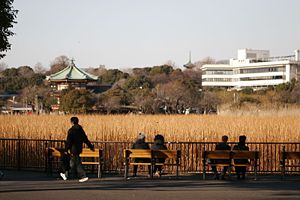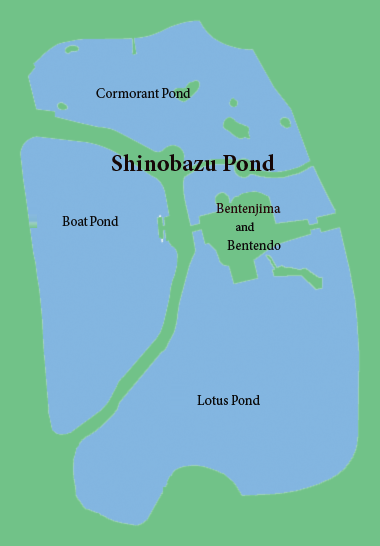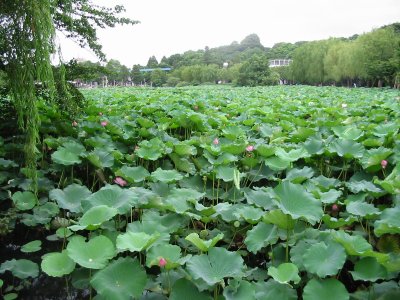
Shinobazu Pond
Encyclopedia

Ueno Park
is a spacious public park located in the Ueno section of Taitō, Tokyo, Japan. It occupies the site of the former Kan'ei-ji, a temple closely associated with the Tokugawa shoguns, who had built the temple to guard Edo Castle against the north-east, then considered an unlucky direction...
(a spacious public park located in the Ueno
Ueno, Tokyo
is a district in Tokyo's Taitō Ward, best known as the home of Ueno Station and Ueno Park. Ueno is also home to some of Tokyo's finest cultural sites, including the Tokyo National Museum, the National Museum of Western Art, and the National Science Museum, as well as a major public concert hall...
section of Taitō, Tokyo
Taito, Tokyo
is one of the 23 special wards of Tokyo, Japan. In English, it calls itself Taito City.As of April 1, 2011, the ward has an estimated population of 168,909, with 94,908 households, and a population density of 16,745.86 persons per km². The total area is 10.08 km².-History:The ward was founded...
, Japan
Japan
Japan is an island nation in East Asia. Located in the Pacific Ocean, it lies to the east of the Sea of Japan, China, North Korea, South Korea and Russia, stretching from the Sea of Okhotsk in the north to the East China Sea and Taiwan in the south...
), and a historically prominent Shitamachi feature often appearing in history and works of art. The park occupies the site of the former Kan'ei-ji
Kan'ei-ji
-External links:** * National Diet Library: ; *...
, a temple closely associated with the Tokugawa
Tokugawa shogunate
The Tokugawa shogunate, also known as the and the , was a feudal regime of Japan established by Tokugawa Ieyasu and ruled by the shoguns of the Tokugawa family. This period is known as the Edo period and gets its name from the capital city, Edo, which is now called Tokyo, after the name was...
shogun
Shogun
A was one of the hereditary military dictators of Japan from 1192 to 1867. In this period, the shoguns, or their shikken regents , were the de facto rulers of Japan though they were nominally appointed by the emperor...
s, who had built it to guard Edo Castle
Edo Castle
, also known as , is a flatland castle that was built in 1457 by Ōta Dōkan. It is located in Chiyoda in Tokyo, then known as Edo, Toshima District, Musashi Province. Tokugawa Ieyasu established the Tokugawa shogunate here. It was the residence of the shogun and location of the shogunate, and also...
against the northeast. The temple was destroyed during the Boshin War
Boshin War
The was a civil war in Japan, fought from 1868 to 1869 between forces of the ruling Tokugawa shogunate and those seeking to return political power to the imperial court....
. The pond, although modified many times and even once drained, is natural.
Position and Dimensions

Ueno Zoo
The is a zoo, managed by the Tokyo Metropolitan Government, and located in Taitō, Tokyo, Japan. It is Japan's oldest zoo, opening on March 20, 1882. It is a five-minute walk from the Park Exit of Ueno Station, with convenient access from Tokyo's public-transportation network...
and takes its name from the birds that inhabit it.
The pond has a circumference of about 2 km and a surface of about 1,100,000m2. To the north it borders with the Ueno Zoo, to the east with Keisei Ueno Station
Keisei Ueno Station
is a train station located in Taitō, Tokyo Japan. It is the terminus of the Keisei Main Line and is in brief walking distance from JR Ueno Station .-History:* 10 October 1933 Opened as "Ueno Kōen Station"* 1 May 1953 Changed name to "Keisei Ueno Station"...
, to the south and to the west with Shinobazu Dori. At its center lies on which stands the temple dedicated to goddess Benzaiten
Benzaiten
Benzaiten is the Japanese name for the Hindu goddess Saraswati. Worship of Benzaiten arrived in Japan during the 6th through 8th centuries, mainly via the Chinese translations of the Sutra of Golden Light, which has a section devoted to her...
.
The park is divided in three parts by two promenades.
| Name | Surface(10,000m2) | Average Depth(cm) | Water volume(1000m3) |
|---|---|---|---|
| Boat Pond | 30 | 86 | 26 |
| Lotus Pond | 55 | 84 | 46 |
| Cormorant Pond | 25 | 92 | 23 |
Origin of the name
According to the stone inscription on Benten Island, the area between the Ueno Plateau and the Hongo Plateau used to be called , and the pond just took its name from it, but there are alternative theories. According to one, the early name due to the presence of bamboo grass later turned into Shinobazu. Another claims the name comes from the habit of young men and women to meet secretly here.History and Changes
In the Jomon periodJomon period
The is the time in Japanese prehistory from about 14,000 BC to 300 BC.The term jōmon means "cord-patterned" in Japanese. This refers to the pottery style characteristic of the Jōmon culture, and which has markings made using sticks with cords wrapped around them...
the entire place used to be just a cove of Tokyo Bay
Tokyo Bay
is a bay in the southern Kantō region of Japan. Its old name was .-Geography:Tokyo Bay is surrounded by the Bōsō Peninsula to the east and the Miura Peninsula to the west. In a narrow sense, Tokyo Bay is the area north of the straight line formed by the on the Miura Peninsula on one end and on...
. Later, some centuries into the Common Era
Common Era
Common Era ,abbreviated as CE, is an alternative designation for the calendar era originally introduced by Dionysius Exiguus in the 6th century, traditionally identified with Anno Domini .Dates before the year 1 CE are indicated by the usage of BCE, short for Before the Common Era Common Era...
, the sea withdrew, leaving behind extensive marshes that covered most of the old Shitamachi. The pond is what remains of those marshes. We know that by the 15th Century the present name was already in use.
In 1625 the Edo Shogunate had the Kan'ei-ji
Kan'ei-ji
-External links:** * National Diet Library: ; *...
built here as a counterpart to Hieizan's Enryakuji in West Japan. The temple's founder Jigen Daishi (Tenkai
Tenkai
was a Japanese Tendai Buddhist monk of the Azuchi-Momoyama and early Edo periods. He achieved the rank of Daisōjō, the highest rank of the priesthood....
), liking Lake Biwa
Lake Biwa
is the largest freshwater lake in Japan, located in Shiga Prefecture , northeast of the former capital city of Kyoto. Because of its proximity to the ancient capital, references to Lake Biwa appear frequently in Japanese literature, particularly in poetry and in historical accounts of battles.-...
, had Benten Island built in imitation of Chikubushima, and then the Bentendo on it. At the time the island was accessible only by boat, but later a stone bridge was added on the east, making it possible to walk to it.
The pond's shape until the beginning of the Meiji Era was very different from now, in particular the northern part where the Ueno Zoo is, which was much wider. At the time, the Aizomegawa flowed into it. In 1884 however, a cooperative horse racing company, wanting to open a racing track, had the pond partly filled, bringing it to the present shape and size. The first horse race took place in the November of the same year in the presence of the Emperor
Emperor of Japan
The Emperor of Japan is, according to the 1947 Constitution of Japan, "the symbol of the state and of the unity of the people." He is a ceremonial figurehead under a form of constitutional monarchy and is head of the Japanese Imperial Family with functions as head of state. He is also the highest...
, and until 1892 races took place every spring and summer.
In 1907 the was built toward the west in occasion of the Tokyo Industrial Fair, making it possible to walk across the whole pond. In 1929 more work divided the pond in four distinct parts. The boat rental business, which continues to the present day, was started in 1939. Today's Cormorants Pond is the result of the fusion of two of those four sections.
During World War II water was pumped out and the pond divided into rice paddies (the so-called . There was later, among others, a plan to build a baseball field on it, but in 1949 it was decided to return the pond to its original form which we still see today.
In September 1967 a hole was opened by accident in the pond during the construction of Tokyo Metro Chiyoda Line, and approximately 30 thousand tons of water flowed away.
In the years between 1990 and 1994, the city authorities installed water purification equipment.
Birds
The pond hosts several dozens of types of migratory and stationary birds, whose number at times is over ten thousand. Among them particularly numerous are tufted ducks, pochards, and northern pintails.Plants
The lotuses of the Lotuses Pond, fully grown in summer, cover the entire surface of the water, hiding it almost completely.
Other Fauna
In June 2006 in the pond were found alligator snapping turtles, which are a non-native species, and the possibility exists that they are breeding. Since then, authorities have posted warnings against alligator snapping turtles and snapping turtles.Famous Literary Works That Mention The Pond
- Mori ŌgaiMori Ogaiwas a Japanese physician, translator, novelist and poet. is considered his major work.- Early life :Mori was born as Mori Rintarō in Tsuwano, Iwami province . His family were hereditary physicians to the daimyō of the Tsuwano Domain...
- Gan (The Wild GooseThe Wild Geese (novel)Mori Ogai's classical novel, The Wild Geese or The Wild Goose was first published in serial form in Japan, and tells the story of unfulfilled love set against a background of social change. The story is set in 1880 Tokyo. The novel contains commentary on the changing situation between the Edo and...
) - Yasunari KawabataYasunari Kawabatawas a Japanese short story writer and novelist whose spare, lyrical, subtly-shaded prose works won him the Nobel Prize for Literature in 1968, the first Japanese author to receive the award...
- Boshi Jiken (帽子事)
Access
- Keisei Line: Keisei Ueno StationKeisei Ueno Stationis a train station located in Taitō, Tokyo Japan. It is the terminus of the Keisei Main Line and is in brief walking distance from JR Ueno Station .-History:* 10 October 1933 Opened as "Ueno Kōen Station"* 1 May 1953 Changed name to "Keisei Ueno Station"...
- Yamanote LineYamanote LineThe is commuter rail loop line in Tokyo, Japan, operated by East Japan Railway Company . It is one of Tokyo's busiest and most important lines, connecting most of Tokyo's major stations and urban centres, including the Yūrakuchō/Ginza area, Shibuya, Shinjuku, and Ikebukuro, with all but two of its...
: Okachimachi StationOkachimachi Stationis a railway station located in Taito, Tokyo, Japan.-Layout:The station is on a raised viaduct running in a roughly north-south direction. There are two island platforms with two tracks on either side of each platform. Tracks 1 and 4 serve the Keihin-Tōhoku Line whilst tracks 2 and 3 are used... - Yamanote LineYamanote LineThe is commuter rail loop line in Tokyo, Japan, operated by East Japan Railway Company . It is one of Tokyo's busiest and most important lines, connecting most of Tokyo's major stations and urban centres, including the Yūrakuchō/Ginza area, Shibuya, Shinjuku, and Ikebukuro, with all but two of its...
, Hibiya Line, Ginza Line: Ueno StationUeno Stationis a major railway station inTokyo's Taitō ward. It is the station used to reach the Ueno district and Ueno Park -- which contains Tokyo National Museum, The National Museum of Western Art, Ueno Zoo, Tokyo National University of Fine Arts and Music and other famous cultural facilities... - Chiyoda Line: Yushima StationYushima StationYushima Station is the name of two train stations in Japan.# Yushima Station - in Ichinoseki, Iwate# Yushima Station - in Bunkyō, Tokyo...
Other information
- The area around the pond used to be the MeccaMeccaMecca is a city in the Hijaz and the capital of Makkah province in Saudi Arabia. The city is located inland from Jeddah in a narrow valley at a height of above sea level...
of Tokyo's homeless, but in 2006 the area was cordoned off and the homeless sent away.

